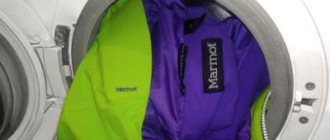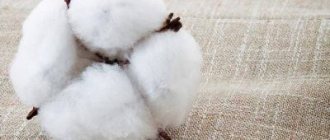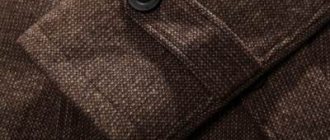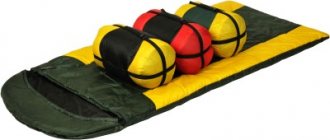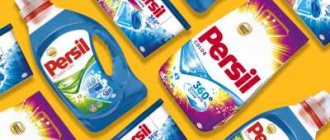- November 14, 2018
- Equipment
- KaplyaDegtya
The Gorka suit was created back in the distant 80s in the USSR for a Soviet soldier. Since then, it has not only not lost its relevance, but has also gained great popularity among civilians. You can still buy costumes that are absolutely identical to those that were created before. The set is sewn from canvas fabric, which is not only durable, but also perfectly protects from heavy rains and wind, from temperature changes and dampness.
In addition, thanks to the camouflage-colored material and the presence of a great variety of various pockets, these suits are in demand among hunters and fishermen, paintball players and mountain climbers.
Costume modifications
The “Gorka” set comes in summer, winter and demi-season versions. How to care for the suit and how to wash Gorka depends on the modification.
All suits, regardless of modification, have some common characteristics, namely:
- Made from tent material that is resistant to rain, wind and dust.
- The lining is made of cotton, which perfectly absorbs sweat, but at the same time allows air to pass through.
- Lots of pockets.
- In places that are subject to increased abrasion, special shaped overlays are sewn.
How to get rid of stains?
Stains on a Gorka suit are a common phenomenon, since its operating conditions are far from ideal.
It is impossible to treat a suit with aggressive detergents, so each owner should know the recipes that can be used to remove various contaminants.
Type of stain and remedy to combat it:
- Ingrained dirt. To remove it, use laundry soap. To make it dissolve better, you can grate it. Apply the finished composition with a sponge to the contaminated areas, leave for 30 minutes, then wipe with a clean damp cloth.
- Blood stains. “Gorka” is often worn for hunting, so the blood of the prey can easily get on the fabric. To remove it, use ammonia (1 tablespoon per liter of water). The solution is applied to the stain using a sponge. After an hour, wipe the suit with a damp cloth.
- Oily spots. Starch works well with them. Sprinkle it on the contaminated area, press it with a napkin and leave for 12 hours. Then the powder is brushed off with a brush. If the stain has not completely disappeared, wipe it with a cotton pad soaked in an alcohol solution.
- Dye. White spirit is used to remove it. It is applied to a cotton pad, which is used to wipe the stain, moving from the edge to the center. When the paint has dissolved, rinse the area of fabric under running water.
- Mold. Mold may begin to grow on a suit that is not dried out. You can remove it with vinegar. It is applied to a cotton pad, which is used to treat the area affected by the fungus. No less effective is salicylic acid 3%. The fabric must be treated with the composition at least 2-3 times, leaving it until completely dry. After cleaning, the suit is washed and thoroughly dried in the fresh air.
You need to start removing stains immediately; the sooner the treatment starts, the more effective it is.
Sometimes, after washing, white marks appear on the suit, which cannot be removed by any means. Most likely, they are represented by creases and abrasions, which are formed due to too intense spinning, or due to exposure to inappropriate detergents.
It will not be possible to restore the primary integrity of the tissue. The tarpaulin can be rubbed with a paraffin candle to restore its softness and water-repellent properties in damaged areas.
Suit care
You should know that not every windproof suit can be called a “Gorka”. In Russia there are only a few manufacturers who sew real “Gorka”, for example, “Bars”, “Tver”, “Splav”, “Ivanovo”. But it is important not only to buy a real “Gorka”, but also to properly care for it. The main care is to clean the suit from dirt in a timely manner and dry it thoroughly after rain. It is better to dry it in a horizontal position, but be sure to dry it completely naturally - this will restore its protective coating. Also avoid exposing the suit to direct sunlight - this will cause streaks to form on the suit, and the material itself is susceptible to fading.
Recovery after washing
When the suit is completely dry, be sure to treat it with a special composition to completely restore the special properties of the item. Polyurethane impregnation from DuPont or NikWax is perfect for this purpose. To ensure that your Gorka suit lasts as long as possible, follow the following conditions for caring for it.
- Clean off dust, dirt and other dry contaminants immediately, without allowing them to become embedded in the fabric.
- Monitor the condition of the item's accessories.
- Buy a special case in which the suit will lie during breaks in use.
Manufacturers also recommend folding the slide in a special way to avoid creases or other unpleasant consequences of improper storage. You can find several guides on this topic on the Internet.
Share your opinion - leave a comment
The “Gorka” suit was created back in the distant 80s in the USSR for a Soviet soldier. Since then, it has not only not lost its relevance, but has also gained great popularity among civilians. You can still buy costumes that are absolutely identical to those that were created before. The set is sewn from canvas fabric, which is not only durable, but also perfectly protects from heavy rains and wind, from temperature changes and dampness.
In addition, thanks to the camouflage-colored material and the presence of a great variety of various pockets, these suits are in demand among hunters and fishermen, paintball players and mountain climbers.
How to wash Gorka?
Since the suit is made of tent fabric, it requires proper care. Both hand and machine washable. Instead of washing powder, it is better to use liquid for washing black or colored laundry.
What does the label tell us about how to wash Gorka?
- Wash at 40 degrees.
- Rinse with a gradual decrease in water temperature.
- Hand spin or in a washing machine at low speed.
- Do not use aggressive substances such as chlorine.
- Dry horizontally on a flat surface.
- Ironing at a temperature not exceeding 250 degrees only on the front side.
In principle, the recommendations are quite standard, so why, according to reviews, are there so many difficulties with how to wash Gorka? Let's look at the main mistakes.
Automatic cleaning
So, first of all, do not use dry powders or other fancy products when washing. It is better to limit yourself to liquid gel or gel in capsule. The slide can be washed only with a delicate cycle and low temperature (about 40 degrees, no more), and these parameters do not differ from manufacturer to manufacturer.
As for spinning, some manufacturers warn that it is impossible to wash a suit with a spin cycle, others allow a similar procedure, but at minimum speed to avoid the appearance of wrinkles.
A controversial issue is the use of a spray to maintain the waterproof properties of the product. Perhaps such a product will serve the purpose during washing, but it will be impossible to use such a suit in the summer.
Errors
The main mistake that occurs when washing a suit is that such a property of the canvas material as shrinkage is not taken into account, and since “Gorka” must be washed correctly at 40 degrees, this condition must be observed. If the water is too hot, the suit can easily shrink several sizes.
Another mistake in how to wash Gorka is using washing powder. Since tarpaulin is a fairly porous material, it is quite difficult to rinse the powder out of the fabric. The easiest way to wash Gorka is to pour cool water into a basin, add liquid detergent and gently clean the suit with a brush.
In addition, the options for how to wash the Gorka suit also depend on its modification.
- Encephalitis suit. Even on the official website you will not find recommendations on how to wash Gorka made from this material. Most likely because specialists insure themselves in case the special impregnation simply washes off during washing.
- Water-repellent suits. We have already given recommendations on how to wash “Gorka” made of tarpaulin above, but it is believed that the fabric loses its water-repellent properties after several washes, so try to wash it as little as possible, sometimes just cleaning it is enough.
What fabric is a Gorka suit made from?
This suit is made from cotton fabric, which is a type of tarpaulin. Many people affectionately call this material a “tent.” After all, earlier in the USSR they made camping tents ; they were quite heavy; when the tent had already been in use for several years, it began to get wet and when you touched its roof, it began to leak. Over time, the slide suit
Depending on the time of year, the fabric changes slightly. For example, in a winter suit they use membrane fabric with insulation: thermotex, alova and cat's eye. Many people, when buying a winter suit, do not know how to wash the slide correctly. It is necessary to place the clothes on a flat surface and wash the suit using a brush, cold water and laundry soap.
In summer, they use the same cotton fabric, only with high-twist thread, which has excellent water-repellent properties. Thanks to it, when wet, the thread will swell and unwind, so moisture will not be able to get inside. In dry weather, the body can “breathe” thanks to the special weaving of the threads.
Demi-season suits are made from the same fabric as all the others, with an increased density of the material. Sometimes they can be additionally finished with raincoat fabric. A slide of this type perfectly protects from wind, rain and cold weather.
How to wash Gorka in a washing machine?
You can often find comments on the Internet that the suit has turned white and stained. Most often, this occurs due to the fact that the owners have not come up with anything better than washing the “Gorka” in a washing machine with the addition of regular powder. This is strictly prohibited! In this case, two basic conditions are violated: washing powder and hot water.
In the instructions on how to wash Gorka, machine washing is allowed, but all the same conditions must be observed as for hand washing. Automatic machines now have many washing modes at low temperatures - choose “Delicate fabrics” or “Gentle wash”.
Manual cleaning
Visitors to various forums are unanimous in the opinion that hand washing is still much safer than automatic washing (even with a delicate program). And therefore, it is a priority. Of course, cleaning the Gorka manually also needs to be done with special care, but at least there is an opportunity to control the process.
- Use water no hotter than 30 degrees for washing.
- For detergent, use either liquid laundry detergent or, preferably, laundry or baby soap.
- Do not add bleaches, stain removers or other special products under any circumstances.
- If there is serious dirt, use a medium-hard brush.
First of all, you need to turn both the pants and the anorak inside out and soak them in warm water for 3 or 4 hours. It is better to use baby soap, and resort to powder only in case of serious, difficult to remove stains. After the specified time has passed, lightly rub the suit, but do not rub or press with all your might. Then rinse a couple of times and squeeze gently. If you are preparing Gorka for the new season, you can treat it with a special shampoo that ensures the preservation of the properties of the fabric.
Disadvantages of the suit
We have already talked quite a lot about its advantages, but some of its disadvantages should also be noted. The main disadvantage is maintenance, since washing Gorka is something like “dancing with tambourines”: one wrong step and you are already the owner of a children’s costume.
In addition, as already mentioned above, after repeated washings the water-repellent properties of the set are lost. Some advise using special water-repellent sprays, but they do not allow the suit to “breathe”; your body will constantly sweat in it. Before washing, carefully inspect the suit; it is quite possible that it will be enough to simply clean it or wipe certain areas with a damp cloth, rather than wash it entirely.
Another drawback is that when it gets very wet, the fabric becomes very heavy, so walking in such a suit on long hikes in bad weather is quite problematic.
Important Tips
Information that all owners of the Gorka costume should know:
If the product is treated with a water-repellent composition, it should be washed as rarely as possible. Frequent contact with water and detergents will wash out the impregnation.- It is necessary to promptly clean the item from dust and dirt, and take care of the fittings.
- Do not use aggressive detergents for washing, such as chlorine, any household stain removers and bleaches.
- Tarpaulin shrinks, so it should not be washed in hot water or boiled.
- Automatic machine drying is used only in emergency cases. It can ruin a suit and cause creases to appear on it.
Sometimes, after wearing, the “slide” remains perfectly clean, but the smell of a fire emanates from the clothes. You can remove it without resorting to washing. It is enough to hang the clothes in the fresh air and leave them to ventilate for a day.
You will find a lot of useful information about washing outerwear here.
Drying the product
Immediately after washing, the suit should be hung vertically for a few minutes to allow the water to drain off (if automatic spinning was not used). It is necessary to dry the “slide” in a horizontal position in a warm, well-ventilated room. To avoid fading, the product should be placed in a shaded place away from direct sunlight.
When laying out the suit, you need to straighten out all the folds. If this is difficult to do, after the suit has completely dried, you need to iron it through the fabric with an iron (no higher than setting 2) with the steam function turned on. The iron temperature should not be higher than 250 degrees.
The suit takes a long time to dry, but it is important that it dry completely naturally, without artificial intervention.
Home > Information > Recommendations for caring for items
How to wash Gorka? How to dry boots? How to wash a Gortex membrane?
How to wash GORE-TEX
It is imperative to follow the manufacturer's instructions for caring for the product! then your things will serve you for a long time and with high quality.
1) Preparation. It is necessary to fasten ALL zippers (main, pockets and underarms), as well as all flaps and straps. Check for foreign objects in the pockets of the product.
2) Washing. The product can be machine washed in warm water (40º C) with a small amount of liquid detergent added. Then rinse twice and spin the centrifuge at low speeds to reduce the formation of wrinkles on the product. Do not use loose laundry detergents or products containing fabric softeners, bleaches, or stain removers, as they may affect the service of the product. Do not use chlorine bleach. Washing powders may contain particles that may not dissolve completely and will remain in the structure of the material, thereby deteriorating its quality. Do not wash with heavily soiled laundry.
3) Drying. You can dry the product on a line or in a dryer in a warm room. To restore the properties of the durable water-repellent coating (DWR-Durable Water Repellent) on the outer layer of the fabric. If it is possible to dry the product in a special dryer, this is better than ironing.
4) Ironing. The product can be ironed, BUT before you start ironing, be sure to check what is indicated in the instructions from the manufacturer. Heat the iron with the steamer, but no more than “1” or “2”; place a thin towel or cloth between the product and the iron. Do not iron the item until it is completely dry. This will help restore the long-lasting water-repellent DWR coating on the outer layer of the item's fabric.
If professional dry cleaning is required, follow the product manufacturer's instructions and ask that a clear, distilled hydrocarbon solvent be used for rinsing. After dry cleaning, it is necessary to apply a water-repellent coating to the outside of the product. Water-repellent coating can be purchased at tourism, sports and recreation stores.
How to wash the membrane. What not to do with the membrane:
- The membrane cannot be washed with powder! All crystalline membrane washing products are strictly contraindicated, because... they will simply clog all the pores of the membrane, and it will stop “breathing”, that is, it will stop working.
- The membrane cannot be washed in a washing machine at temperatures above 40 degrees C, you will simply weld it, all the pores will stick together and the product will become unusable. If the jacket is colored, after washing in hot water it may become uniformly brown in color.
- All detergents containing chlorine and its derivative components are contraindicated. After such washing, the membrane will certainly begin to get wet. Thus, the water-repellent protective properties of the membrane fabric are reduced.
- The membrane must not be squeezed out. Twisting the fabric will accelerate the destruction of the membrane by stretching and mini-tears.
- The membrane cannot be dried on a radiator. Hot drying will cause the pores of the membrane to “stick together” and it will lose its functions.
- The membrane cannot be ironed. Because everything will just melt.
- Do not use rinse aids or conditioners. The chemical composition of conditioners may have an adverse effect on the fabric.
How to properly wash the membrane:
- Read care instructions. The care designation system is simple and uniform throughout the world (there is a table below with a breakdown of the designations).
- Wash at a temperature no higher than 30-40 degrees C.
- Wash with special detergents for washing membrane fabrics; they can be purchased at tourism, sports and recreation stores. You can use liquid laundry detergent after carefully studying its composition. Or ordinary soap. Soap will also help get rid of stains; wash the product or part of it with plain soap, then rinse in cool water.
- The product can be wrung out manually without twisting.
- Dry the product in a well-ventilated area without direct exposure to sunlight and high temperatures.
- After washing, the membrane must be impregnated.
Products using membranes are impregnated during the production process with a special protective composition DWR, which envelops the threads of the material. But over time, this protective layer is wiped off and comes off during washing. The product begins to get wet in places especially on the shoulders (due to the bag and backpack) and folds. The water does not roll off, the product begins to get wet, and you become cold. Impregnations restore the properties of fabric and extend the life of clothing. Impregnation can be either liquid or in the form of an aerosol, with the help of which the water-repellent properties of the product are restored. If the impregnation is liquid: the product must be rinsed in a solution with impregnation (in accordance with the instructions on the impregnation bottle); if the impregnation is in the form of an aerosol, spray it on clothes.
How to wash a Gorka suit
Recommendations for washing a Gorka 3K and 4 suit from the manufacturer:
- Machine and hand wash. Reduced mechanical cycle.
- Wash in warm water (max t ° 40C) with a mild detergent (powder).
- Rinse with a gradual decrease in water temperature. The spin is weak.
- Do not bleach with chlorine-containing substances.
- Ironing on the front side at a pressing surface temperature of 150-250°C.
Based on personal experience and the experience of friends/acquaintances in using the Gorka field suit, we can say the following:
- “Gorka” should be washed in cool water (temperature 30-40°C) with soap and a brush.
- It is better to squeeze it by hand or at low speeds in the washing machine (400-600 revolutions), then the likelihood of creases and whitish stripes forming is minimal.
- Dry in well-ventilated areas or outdoors, avoiding direct sunlight.
- After several washes, “Gorka” may get wet more than usual, there is experience in treating it with water-repellent agents, but you need to take into account that it will also “breathe” less.
How to care for boots
First of all, you need to comply with a simple condition - choose a model of special shoes that will suit the operating conditions. That is, you should wear shoes in accordance with their seasonal purpose.
Boots must be measured on a thick toe, or when trying on, take into account that they should not press on the leg, but at the same time they should fit snugly on the leg. If they dangle, rub the calluses. If the ankle boots are a little tight, you can stretch them using special means for stretching shoes (apply the product on the inside and outside of the shoes, wear thick socks and walk around for a couple of hours). You can use folk remedies: moisten a napkin with medical alcohol, wipe the inside of the ankle boots and put them on, you can also moisten your socks with alcohol and put them on. Walk around in the boots for a while, then take them off and stuff them tightly with newspaper. Leave it like this overnight. You can use the services of shoe workshops; they can stretch shoes in length and width.
New shoes must be treated immediately. To increase the water-repellent effect, you need to lubricate the boots with shoe polish and coat the seams and joints well. You can use shoe wax, as well as glycerin and castor oil. Subsequently, after each outing, you need to clean the boots from dirt with a damp cloth/sponge, then apply protective wax using special shoe brushes or an old toothbrush.
It is best to clean shoes at night, because... it will be able to soak well enough and will not lose its shape in the future, and it can be polished in the morning. Polish well using cloth. However, many experts and lovers of such shoes do not recommend polishing the shoes too much, as they may lose their ability to “breathe” (don’t forget leather is a natural material). If you are caught in heavy rain (sleet), you should immediately wipe your shoes with a damp cloth/sponge to avoid salt stains. In order to dry the ankle boots inside, you can stuff them with newspapers, BUT do not dry them on the radiator. After they are dry, wipe them again and apply shoe polish.
In cold weather, it is a good idea to lubricate boots made of genuine leather with natural fat, such as lamb or seal fat; it gives the leather elasticity, allowing it to be used at low temperatures. Then, as usual, lubricate the boots with cream.
Also, do not forget about the insoles - wash them in warm water, preferably with soap, and do not dry them on a radiator. It is recommended to air shoes after wearing them. During particularly hot summer weather, or when used in humid and hot climates, it is recommended that you change your socks at least once a day. Remove your boots and dry your feet as best you can. Clean your boots from any clumps of wet mud and clay. Use wax or shoe polish containing silicone. Clean the forced ventilation openings thoroughly. If there is water in the boot, drain it. Wipe the inside of the boot with a damp cloth and soap, then dry it thoroughly. You need to clean your boots as often as possible.
Do not dry directly over a fire - it will damage the skin and fabric. Also, before putting on your boots, check for bugs and spiders inside.
Conclusion:
- shoes made of genuine leather: use cloth, sponge, paper napkin. Wash and wash in cool water.
- shoes made of suede and nubuck: use a special rubber brush and a brass brush. Shoes can be cleaned with a rubber brush, as well as brass wire. Wash and wash with cool water.
— shoes made of fabric (Cordura, Kevlar, etc.): do not use aggressive methods. Clean and wash in cool water, use a sponge or cloth, dry with a soft cloth. The fabric can be treated with special sprays that preserve the water-repellent properties of the product.
How to wash fleece.
British police fleece jackets:
Product care instructions:
- wash the product together with similar ones in color and texture;
- do not use regular detergents and fabric softeners;
— machine washable at a temperature of no more than 40° C;
- delicate spin; - cannot be dry cleaned;
- Do not iron;
— do not use chlorine-containing bleaches;
— do not store in a damp state (always make sure that the product is thoroughly dry if it is wet after rain, etc.);
- do not dry over a radiator;
In order to preserve as much as possible all the beneficial qualities of this material, you must follow the rules of care. Today, fleece is practically the most popular material for sports, recreation and tourism. Fleece is a synthetic material (polyester). A modern material that has the following properties:
· fleece absorbs moisture from the body and wicks it out, leaving you warm and comfortable;
· fleece is very light;
· fleece keeps its shape very well, the product does not lose its appearance even after very long wear and repeated washing;
· fleece allows the body to “breathe” as there are tiny “bubbles” in the fabric structure and maintain an optimal temperature, which gives a feeling of comfort;
· fleece dries quickly;
· fleece does not require special care, you just need to wash it, shake it and hang it up;
· fleece is a very durable material;
· fleece does not cause allergies and can even be used in children's clothing.
How to wash fleece:
· fasten all zippers, pockets, flaps and buttons;
· washable in a washing machine at a temperature of no more than 40°C (washing mode for synthetic fabrics);
· do not use bulk washing powders, since if they are not completely dissolved, the particles will remain in the fabric of the product;
· You can use liquid washing powders for washing delicate fabrics;
· Do not bleach;
· if a fleece product contains membrane layers, then you cannot use fabric softeners for washing (see How to wash a membrane);
· heavy stains can be washed off with laundry soap; as a rule, all stains come off very well;
· you cannot spin the product in a washing machine at a centrifuge speed of more than 400; it is also not recommended to twist the product by hand;
· Dry on a hanger or in a dryer away from radiators and open flames.
Rules for caring for T-shirts.
For long-term use, it is necessary to follow the rules of product care:
- Wash at temperatures up to 40 degrees and preferably manually
- Press at medium speed
- Dry naturally
- Use suitable detergents for washing
- Iron at the right temperature
A little more about each point:
- Washing thin items (T-shirts) made of cotton and footer (sweatshirts, etc.) at temperatures above 40 degrees is almost guaranteed to cause the items to shrink. Observe temperature conditions.
- Press at low speed
- Pay attention to the purpose of the detergent. Do not use products with bleaching properties.
- Gently straighten on a hanger.
- Do not dry in the open sun!
- Observe the recommended iron temperature.
How to prepare a product for washing?
They wash the “slide” in the machine. This is the least labor-intensive way to clean a suit. Before you begin the main procedure, you need to properly prepare the item.
Procedure:
All zippers, valves and belts are fastened on the suit.- Pockets are cleared of debris. There should be no foreign objects in them.
- Study the manufacturer's information, which is indicated on the label. His recommendations should not be violated.
The fact is that under the same name the Gorka suit is produced by different factories.
- Shake your jacket and pants well to knock the dust out of them.
- Clean off dirt and remove stubborn stains.
After the preparatory activities are completed, you can begin the main wash.
What clothes will shrink after washing
Almost any fabric can be stretched and tightened to your liking. Some materials lend themselves better to this, some worse. It all depends on the texture of the fabric; for some materials, just a couple of washes in hot water is enough
To prevent unwanted changes to your laundry, pay special attention when cleaning the following items:
- Knitwear will definitely shrink after washing, due to the specific fiber structure inherent in this material. The threads from which it is made are twisted too tightly; it is enough to hold them in water at a temperature slightly higher than indicated on the tag to achieve a change in size.
- To shrink acrylic products, 30 degrees of water or higher is enough. In this case, you should be extremely careful not to damage the item; use special laundry bags. Make the spin mode as weak as possible.
- Viscose. This type of fabric is rarely used alone in the manufacture of clothing. When shrinking items made from several types of fabric, it is necessary to work on the most delicate fabric using one of the methods listed below.
What to do to prevent the item from shrinking after washing:
- Follow the cleaning instructions on the product label.
- Do not use when ironing at high temperatures.
- Avoid spinning and harsh washing machine settings.
- While drying things, try to avoid fading under the sun. Do not dry clothes on a hot radiator.
Washing a T-shirt by hand
The washing machine is a great invention of mankind; millions of women glorify this miracle of household appliances. However, some items still need to be washed by hand in order to preserve the original design and brightness of the colors. What types of T-shirts are hand wash only? Let's list them:
- wool T-shirts;
- polo shirts with stiff collars;
- colored T-shirts with a sharply contrasting print - black and white, with a luminescent pattern on a dark background, etc.;
- children's T-shirts with bright stickers and photo printing;
- original T-shirts with rhinestones, sequins, stones and chains;
- knitted T-shirts.
Machine washing does everything for us, but hand washing T-shirts still needs to be explored.
Pour moderately hot water into a container and dissolve the detergent in it. Colored fabrics should be washed in lukewarm water with detergent.
Modern powders do not dissolve well in water; soapy liquid needs to be stirred thoroughly for some time. When using hand washing with regular powder, you must remember that powder granules may remain on clothing later.
Laundry soap is a poor assistant for hand washing; it is difficult to rinse out of fabric fibers.
Therefore, it is better to use washing gels available in hardware stores.
Depending on the color of the T-shirt, we select a gel - “for black items”, “for colored fabrics”, “for mixed colors”, “for woolen items”. Dissolve the gel, turn the T-shirt inside out, immerse it in water and leave it in the basin for a deeper effect.
After some time, we begin to carefully wash, paying attention to problem areas: the armpit area, the collars of polo shirts, dirty inner seams. Squeeze slightly, without twisting too much, straighten the collars correctly with your hands
We do not wring out products with stones and stickers at all; we place them in a dry container or bathtub to drain the soapy water. We change the water to clean water, first warm, then cold. Rinse the T-shirts, changing the water several times.


